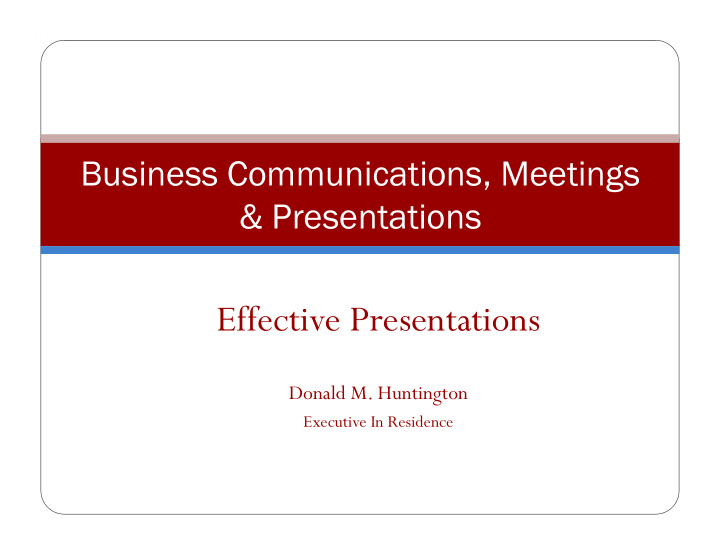



Business Communications, Meetings & Presentations Effective Presentations Donald M. Huntington Executive In Residence
Agenda Presentation types Determining Most Appropriate & Effective Types Keys to Effective Presentations Creating and Planning, Location and Room Setup Delivery and Stage Presence
Types of Presentations Choose Informative presentation “type” to suit Persuasive your objective! Instructional / Training Arousing / Motivational Decision-making Goodwill / Image Building
Informative Presentations Purpose – to inform Brief and to-the-point Factual Who, what, when, where, how, why? Organizational Structures Time Place Cause & Effect Logical Order
Persuasive Presentations Purpose is to convince Presents solution to a controversy, dispute, problem Uses logic, evidence, emotion A persuasive presentation must: Seize audience attention Disclose the problem, dispute, controversy Tantalize by describing the benefits of solving the problem Create desire by describing the benefits of your solution Close with a call to action What you want them to do How and when to do it
Instructional Presentations Purpose - give specific instructions or orders leading to new knowledge or skill An effective instructional presentation will: Explain the value of the new knowledge or skill Explain the learning objectives Explain & demonstrate the process Ask the audience to practice/participate Field questions and ask for feedback Ask the audience how they will use what they learned
Motivational Presentations Purpose - to arouse the audience’s emotions and intellect so they will be receptive to your point of view Use vivid language and voice Project sincerity and enthusiasm
Decision-making Presentations Purpose - to move your audience to accept your recommendation and to take action on it Present ideas, recommendations and arguments logically Explain the benefits of adopting your recommendation and the risks/costs of rejecting it Call to action - what needs to be decided and how each participant can be a part of the solution
Goodwill & Image Building Presentations Purpose - to build goodwill Make the audience feel good about themselves, their peers, colleagues, organization Ceremonial, awards presentations, dedications, eulogies, roasts, etc. Should be entertaining, uplifting (avoid controversy) Often include videos, music, frequent calls for applause
Keys to Effective Presentations Know your subject matter 1 Know your audience 2 Know yourself (strengths and limitations) 3 Develop a theme 4 Write your script (Opening – Body – Closing) 5 Decide on visuals (PPT, Charts, Whiteboard, Physical 6 Props) Prepare your visuals 7 Rehearse several times (Get feedback) 8
Location and Room Setup Plan and check everything Accessibility Room layout and seating (capacity & arrangement) Lighting Sound (Noise) Clutter Check technology (Have a backup plan) Podium, head table, etc. Own the room – make it yours
Delivery and Stage Presence Nerves Poise and Posture Gestures and Movement Vocal volume and vocal qualities Modulation, enunciation, tone Flow and filler words Enthusiasm Facial expressions Eye contact
Tips for the Effective Use of PowerPoint and Keynote
Make type BIG enough This is Arial 12 This is Arial 18 This is Arial 24 This is Arial 32 This is Arial 36 This is Arial 44
Keep it SIMPLE
FONT tips Use easy-to-read fonts Italics can be tough to read Normal or bold ld fonts are clearer Underlines may signify hyperlinks Instead, use a colo lor to emphasise
Don’t use too MUCH text Too Busy! Instructional Technology: � A complex integrated process involving people, procedures, ideas, devices, and organization, for analyzing problems and devising, implementing, evaluating, and managing solutions to those problems in situations in which learning is purposive and controlled � (HMRS 5th ed.) � Hard-to- Boring! read Type
RIGHT AMOUNT of text Instructional Technology: A process involving people, procedures & tools for solutions to problems in learning.
Use visuals to SUPPORT A strategy not on target is no strategy at all. Not DISTRACT A strategy not on target is no strategy at all.
Use a CLEAN design template
Recommend
More recommend